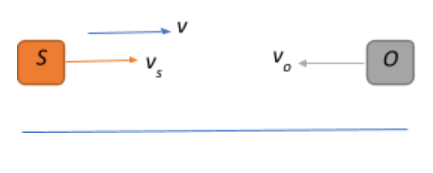Question
Question: A source and an observer move away from each other, with a velocity of \(15\;ms^{-1}\) with respect ...
A source and an observer move away from each other, with a velocity of 15ms−1 with respect to the ground. If the observer finds the frequency of sound coming from the source to be 1950Hz, then the actual frequency of the source will be: (velocity of sound = 340ms−1)
A. 1785 Hz
B. 1968 Hz
C. 1950 Hz
D. 2130 Hz
Solution
Try and recall the trend of frequency change with respect to a relative motion between the source and the observer. In other words, we can use the principle of Doppler effect, which states that if a sound wave source is moving towards or away from an observer its frequency as heard by the observer will be greater than or less than the original frequency respectively.
Use this to first determine the apparent velocity of the sound wave as heard by the observer and the apparent wavelength of the sound wave as seen by the observer. Dividing the apparent velocity and wavelength will give the apparent frequency of the sound wave in terms of the original frequency, and rearranging this equation and substituting the values should give you the appropriate result.
Formula used: Apparent frequency f′=f.(v+vsv−vo)
Complete step by step answer:
We are given that the source and the observer are moving away from each other.
This means that if the velocity of the source with respect to the ground vs=15ms−1 then the velocity of the observer with respect to the ground is vo=−15ms−1.
We are given that the sound emitted by the source travels with a velocity vs=340ms−1 in the direction of motion of the source, and let the wavelength of sound emitted be λ. Let the frequency of the sound wave is emitted by the source be fHz

Since the sound waves are incident in a direction opposite to the motion of the source of the observer, the relative velocity with which the sound waves reach the observer will thus be: v′=v−vo and
And consequently, the apparent wavelength of the sound waves as received by the observer will be the ratio of the effective speed of the sound wave is emitted by the source and the frequency of the sound wave emitted by the source:
λ′=fv+vs
Therefore, the apparent frequency of the sound wave as heard by the observer will be:
f′=λ′v′=fv+vsv−vo=f.(v+vsv−vo)
Given that f′=1950Hz, v=340ms−1, and vs=15ms−1=vo we can find the original frequency of the sound wave as:
1950=f.(340+15340−15)
⇒1950=f.(355325)
⇒f=3251950×355=325692250=2130Hz
So, the correct answer is “Option D”.
Note: Note that we did not consider the negative sign for the observer velocity while substituting its value since we already accounted for the negative relative velocity while obtaining the expressions for the velocity and wavelengths.
Also, in case the source and the observer are moving away from each other:
Apparent sound wave velocity with respect to observer: v′=v+vo and
Apparent sound wavelength as received by the observer: λ′=fv−vs
Apparent frequency of sound wave as received by the observer: f′=λ′v′=f.(v−vsv+vo)
